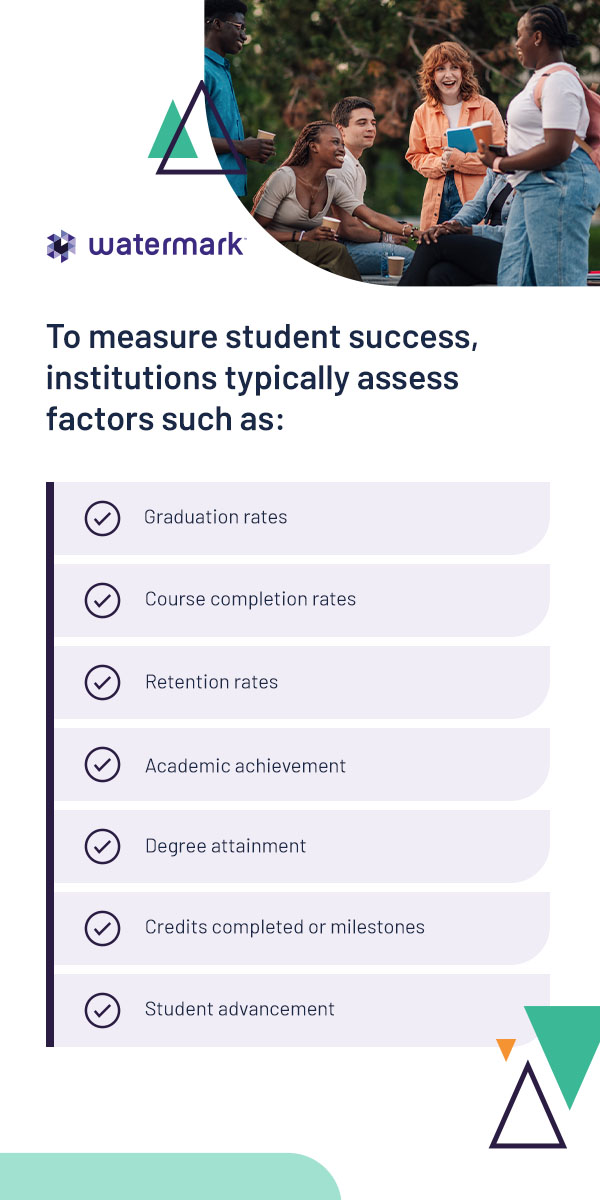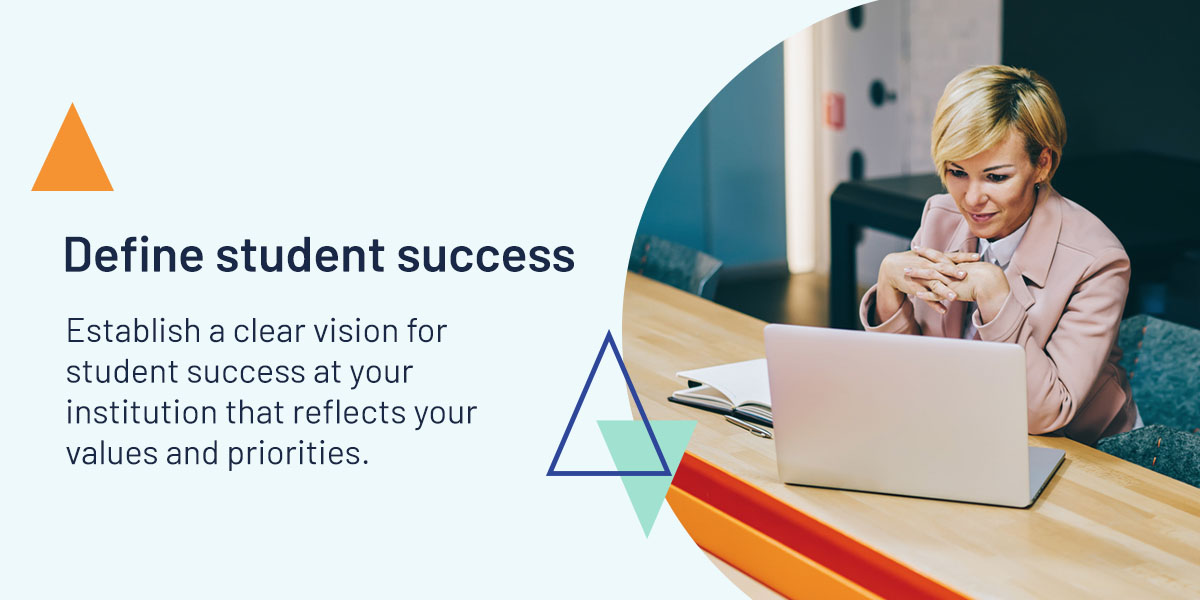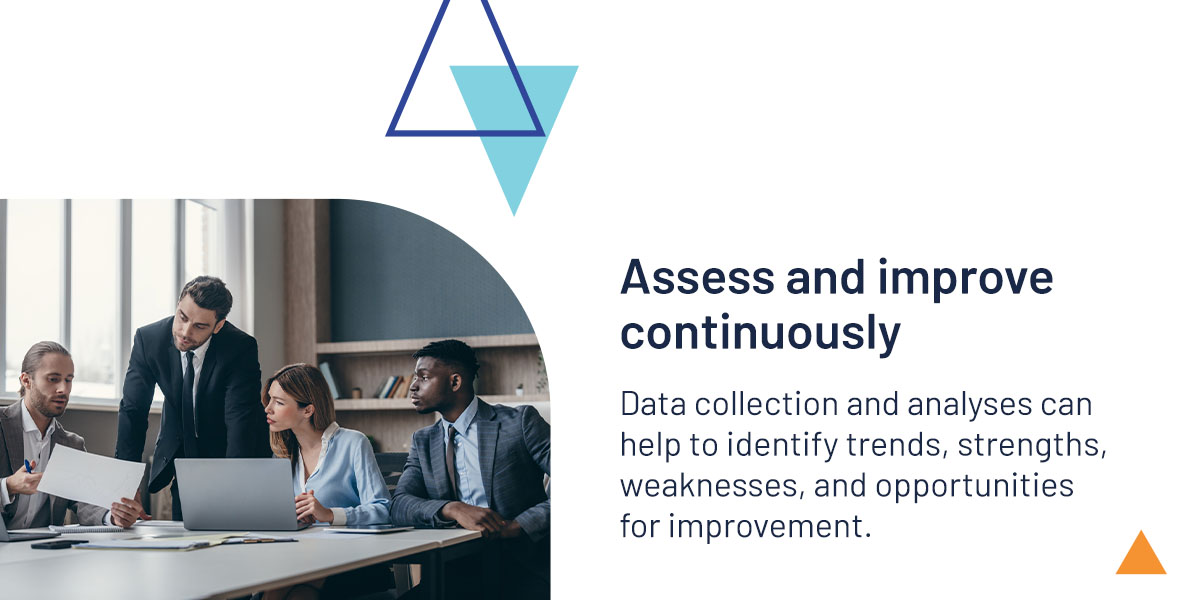



When planning for student success, the focus should be on keeping students enrolled at your college or university and ensuring they achieve their goals. This involves creating a supportive environment that helps students succeed academically, personally, and professionally.
In addition to providing assistance for students at risk of dropping out, higher education institutions must juggle financial pressures, changing demographics, and evolving job markets. Student retention and graduation numbers often relate directly to institutional reputations and funding. As an administrator, you want to ensure you effectively support learners throughout their academic journey. With a strategic planning process focused on student success, your organization can help individuals thrive beyond their time at your institution.
Learn how to introduce a comprehensive, long-term approach to student success that goes beyond traditional retention rate strategies with data-driven approaches.
Student success is the achievement of academic, personal, and professional goals throughout a student’s educational journey. It encompasses various outcomes that contribute to overall development and well-being, making it a top priority for higher education leadership teams. This holistic approach reflects positively on higher education institutions and indicates effective academic practices.
To measure student success, institutions typically assess factors such as:
Although these are easy numbers to track, student success extends beyond educational performance. It includes how students relate to peers, integrate into their communities, and access necessary resources — this requires colleges and universities to recognize who their students are on a personal level, what they expect from their experience, and where they seek support.
Students have unique and diverse definitions of success, which include personal development goals. Ultimately, fostering an environment that prioritizes student success involves acknowledging these multifaceted influences and creating tailored experiences that support holistic growth for today’s diverse and digitally savvy college students.
Student retention and success are often discussed in the context of student affairs, although they represent different concepts and focus areas.
Student retention refers to the ability of an institution to keep learners enrolled from one academic term to the next until graduation. It focuses primarily on preventing student attrition and often includes the following interventions:
In contrast, student success includes a broader range of outcomes beyond keeping students enrolled. It recognizes that learners benefit from higher education by thriving in diverse ways:
Strategies include comprehensive support systems that address academic performance, mental health, community engagement, and career preparation.
Higher educational institutions that prioritize student success through strategic planning are more likely to see sustainable improvements in student persistence and completion rates. When they demonstrate a commitment to learner success, they’re more likely to attract more prospective students and funding opportunities from an improved public perception.
Career preparedness and lifelong learning are critical components to implement in student retention strategies for the following reasons:
Creating a strategic plan for student success requires collaboration among various stakeholders, data-driven decision-making, and a commitment to continuous improvement.
Keep the following tips in mind when creating your institution’s strategic plan:
Below is a step-by-step guide to developing an effective strategic plan.
Establish a clear vision for student success at your institution that reflects your values and priorities. Your vision should outline desired student outcomes. Your objectives for student success must align with your college or university’s broader mission and goals.
Students also need a clear vision to understand what you expect of them and the steps needed to achieve their goals. When students are unsure how to reach vague objectives, they may become discouraged, especially if they lack knowledge of available resources.
Form committees or working groups focused on different aspects of student success, such as academic support, career services, and mental health.
Involve key stakeholders from faculty, staff, administrators, students, and alumni in the planning process. Their different experiences and perspectives are invaluable in understanding student needs.
Your stakeholders can also provide valuable insight into curriculum and course design, ensuring your academic programs are relevant and flexible to suit diverse learners.
Gather quantitative and qualitative data to assess current student outcomes, challenges, and areas for improvement. Analyze this data to identify gaps in services or support that may hinder student success.
Leveraging data modeling and analytics to anticipate student needs and drive data-driven decision-making can revolutionize your student success initiatives.
Higher education institutions now serve a diverse student population, including adult learners, part-time students, and full-time workers. Furthermore, prospective students seek value and a return on investment from their education amidst economic uncertainty. The following areas continue evolving in higher education:
Determine what resources would be needed to implement strategies that will meet students’ needs. Every initiative will need a unique action plan, including:
Develop a clear timeline for implementing each initiative and assign responsibilities to specific teams or individuals. Ensure all stakeholders understand the strategic plan and their roles in supporting student success.
Schedule regular strategic plan reviews to assess its effectiveness with stakeholder feedback. Use data tracking systems to monitor key performance indicators related to student success. Data is incredibly useful for supporting your institution’s learners, ensuring educators have the insights they need to tailor interventions and offer timely assistance.
Implementing student success initiatives is an ongoing process that requires commitment from all levels of your university or college. Use the following steps to create a supportive environment that fosters student achievement and well-being.
Student success needs to start throughout the student’s whole journey, from their university application until graduation day.
Explore key elements of cultivating a culture of success below:
Ensure that the necessary resources are easily accessible to all students. Use the needs assessment to inform your decisions and consider the following:
Remember that a strategic plan will need continuous updates and modifications as time goes on. Data collection and analyses can help to identify trends, strengths, weaknesses, and opportunities for improvement.
Here’s how you can use data to assess your strategic plan’s implementation:
Success metrics used to be tracked by an institution’s first-year retention, graduation rate, and degree output. Today, universities and colleges need to incorporate several key metrics to assess students’ overall success as well balanced individuals. These insights may include:
Using more than academic performance metrics enables your institution to gain valuable insights into student achievement, engagement, well-being, and overall success. A data-driven approach allows you to identify areas for improvement and implement targeted strategies that may enhance the educational experience for all students.
Planning for student success requires robust data collection and analysis. An education platform can streamline data gathering across various departments, allowing administrators to make informed decisions based on real-time insights into student performance, engagement, and outcomes. They can then identify at-risk students early and implement targeted interventions, moving beyond mere retention efforts to proactive support for student success.
With Watermark Student Success & Engagement, you can quickly create custom dashboards or reports, get early alerts when students veer off course, and collaborate with students to create a plan for success. Your platform can be customized to fit your institution’s unique needs, allowing for adaptable strategies that evolve with changing student demographics and academic landscapes.
Offer personalized support before students need it most. Request a demo today.






























































































































































































































































































































































































Submit this form to schedule a meeting with one of our reps to learn more about our solutions. If you need customer support instead, click here.



